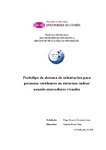Prototipo de sistema de orientación para personas invidentes en entornos indoor usando marcadores visuales

Use this link to cite
http://hdl.handle.net/2183/39704
Except where otherwise noted, this item's license is described as Atribución-NoComercial-SinDerivadas 3.0 España
Collections
Metadata
Show full item recordTitle
Prototipo de sistema de orientación para personas invidentes en entornos indoor usando marcadores visualesAuthor(s)
Directors
Barral Vales, ValentínDate
2024-06Center/Dept./Entity
Universidade da Coruña. Facultade de InformáticaDescription
Traballo fin de grao (UDC.FIC). Enxeñeria informática. Curso 2023/2024Abstract
[Resumen]: En este proyecto se ha desarrollado un prototipo de sistema de orientación para personas invidentes en entornos interiores, utilizando marcadores visuales. El prototipo se ha construido
usando una Raspberry Pi Zero conectada a una cámara capaz de detectar códigos ArUco y
estimar su distancia y ángulo a ellos. Se ha diseñado un bot de Telegram mediante el cual los
usuarios pueden suscribirse y recibir notificaciones en su smartphone cada vez que hay un
nuevo código a la vista o una diferencia significativa en la posición. Un servidor central se
encarga de recopilar, transformar y distribuir los datos enviados por el dispositivo de localización hacia los usuarios. Para el desarrollo de este trabajo se han utilizado tecnologías como
Python con OpenCV para la detección de códigos, MQTT para el transporte de los datos y la
librería Telebot para construir el bot de telegram. [Abstract]: This project has developed a prototype orientation system for blind people in indoor environments, using visual markers. The prototype has been built using a Raspberry Pi Zero
connected to a camera capable of detecting ArUco codes and estimating its distance and angle
to them. A Telegram bot has been designed through which users can subscribe and receive
notifications on their smartphone every time there is a new code in sight or a significant
difference in position. A central server is responsible for collecting, transforming and distributing the data sent by the location device to the users. For the development of this work
we have used technologies such as Python with OpenCV for code detection, MQTT for data
transport and the Telebot library to build the telegram bot.
Keywords
Sistema de orientación invidentes
Raspberry pi
OpenCV
Python
ArUco
Localización indoor
MQTT
Blind orientation system
Indoor location
Raspberry pi
OpenCV
Python
ArUco
Localización indoor
MQTT
Blind orientation system
Indoor location
Rights
Atribución-NoComercial-SinDerivadas 3.0 España






